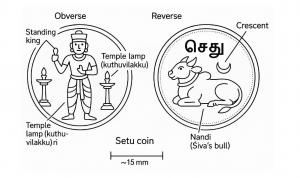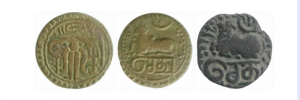'Setu' coins affirm a medieval Tamil sovereignty in northern Sri Lanka
Setu wasn’t just a coin. It was a metal emblem of state. Tamil legend and Saiva symbols place Jaffna’s kingship in a wider Tamil world across the Palk Strait.”
NEW YORK, NY, UNITED STATES, October 20, 2025 /EINPresswire.com/ -- The US Tamil Diaspora today released a concise research brief showing that the “Setu” (or “Setu bull”) coins of the Jaffna kingdom represent a distinct Tamil royal issue and a clear statement of Tamil political authority, language, and Saiva religious identity in northern Sri Lanka from the late 13th to the 16th century.— Editor, Tamil Diaspora News
What are Setu coins?
Setu coins are copper issues struck by the Aryacakravarti kings of Jaffna (Yalppanam). The obverse typically shows a standing ruler flanked by temple lamps. The reverse shows Nandi (the bull of Siva) with a crescent above and the Tamil legend “செது” (Setu). The legend references Rama Setu (Adam’s Bridge) and the royal biruda Setukavalan or “Guardian of the Setu,” linking Jaffna’s rulers to the sacred center of Rameswaram and to older Pandyan claims across the strait.
Why this matters
— First attested Tamil-legend coinage on the island, marking Tamil language in state media.
— Royal Saiva iconography signals a Tamil religious and cultural program in power.
— Findspots concentrate in northern Sri Lanka and south Tamil Nadu, reflecting a cross-strait Tamil maritime economy (ferries, pearl fisheries, and trade).
— Chronology aligns with the Jaffna kingdom’s rise after Chola rule and amid late Pandyan influence; minting ceases after the Portuguese conquest (1619–1621).
Evidence of Tamil sovereignty expressed in coinage
— Issuer: Aryacakravarti kings of Jaffna (Tamil Hindu polity).
— Language: Tamil “செது” on the reverse.
— Religion: Nandi and lamps emphasize Saiva identity.
— Territorial claim: “Setu” and the Setukavalan title tie the polity to Rameswaram–Adam’s Bridge.
— Economy: Small-denomination copper for everyday circulation in a Tamil coastal network.
Historical context (brief)
— Late 13th–14th c.: Emergence of the Aryacakravarti line; establishment of Jaffna coinage.
— 16th–early 17th c.: Final Setu series; discontinuation following the Portuguese overthrow of Jaffna (1619–1621).
Quotes
“The Setu coin is not just currency; it is a state emblem in metal,” said a spokesperson for the US Tamil Diaspora. “Its Tamil legend, Saiva symbolism, and Setu title locate Jaffna’s kingship squarely within a wider Tamil world across the Palk Strait.”
“This brief brings together numismatic, geographic, and textual clues to show how a medieval Tamil sovereignty spoke in its own language on its own money,” said the brief’s lead editor.
Availability
A short illustrated explainer, line-art diagrams of the types, and a transliteration note on the Tamil legend are available on request.
About US Tamil Diaspora
US Tamil Diaspora is a non-profit civic group that researches and advocates for the history, rights, and cultural heritage of Tamils worldwide, with a focus on evidence-based public education.
Editor
Tamil Diaspor News
+1 516-308-2645
email us here
Legal Disclaimer:
EIN Presswire provides this news content "as is" without warranty of any kind. We do not accept any responsibility or liability for the accuracy, content, images, videos, licenses, completeness, legality, or reliability of the information contained in this article. If you have any complaints or copyright issues related to this article, kindly contact the author above.


